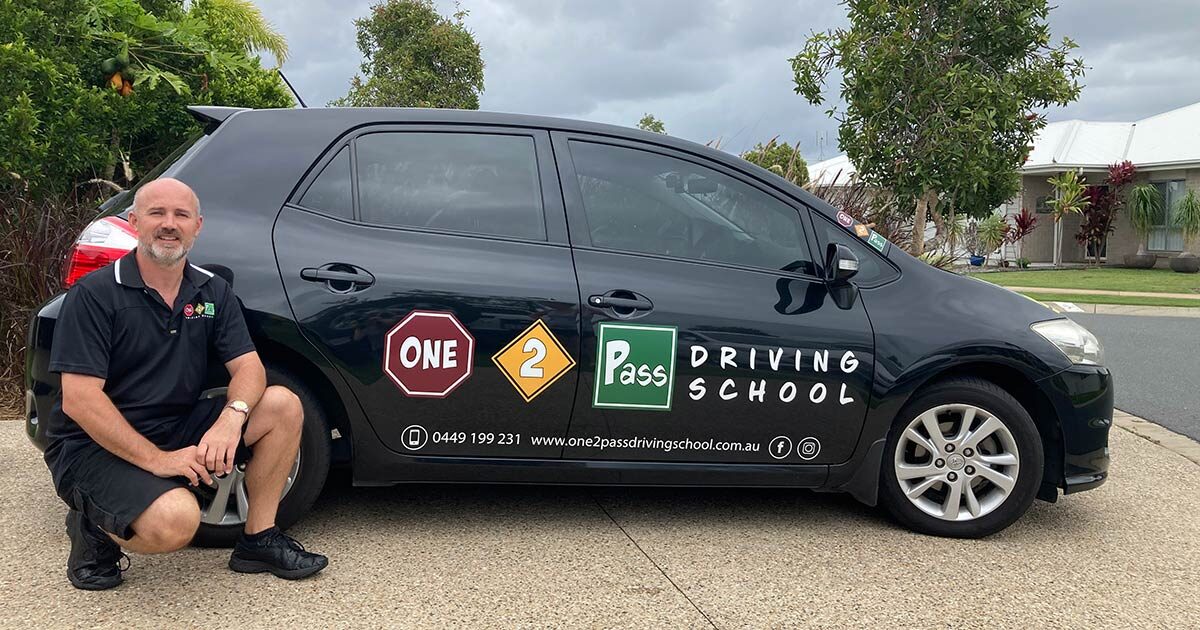Hi James here from One 2 Pass Driving School, a Caloundra driving school instructor.
Today I’m going to talk about Speed and braking distances.
As per normal on my blogs, I’m going to base this on my own personal opinion or experience and / or supported from sources, facts and / or legislation quoted for driving on Queensland’s roads.
Let’s get some facts!
About Speeding.
Speeding is one of the major causes of fatalities on Queensland roads. Speeding is defined as driving over the posted speed limit or at a speed that is inappropriate for the driving conditions (e.g. rain, fog, traffic volume, traffic flow). Speeding is not safe in any circumstance.
Driving within the speed limit maximises your stopping distance, giving you more time to react to:
- the actions of other road users around you like vehicles, pedestrians and cyclists
- changes to the road environment itself such as pot holes and obstacles.
Speed limits are set and enforced to reduce crashes and save lives. Fines and demerit points apply when a person is caught driving a vehicle above the posted speed limit.
During 2019 there were 48 fatalities as a result of crashes involving speeding motorists, representing approximately 22% of the Queensland road fatalities.
Visit road safety statistics to find out more information on Queensland’s road crash data.
Speed-relate social costs
Road crashes are a tragedy and impact families, communities, emergency personnel and health services.
Speed-related fatalities and hospitalised casualties in Queensland have an estimated cost of $3.2 billion each year. This is based on road crash data from 1 Jan 2012 – 31 December 2016. Social cost figures are provided in 2017 dollar value using the Bureau of Infrastructure, Transport and Regional Economics 2006 social cost estimates.
Suburban speed limits
The speed limit in built-up areas in Queensland is 50km/h unless otherwise indicated by signs.
Road worker safety
Roadworks are necessary to build new roads and keep our existing roads safe however, roadwork sites can be dangerous. You need to take extra care when driving through roadworks, this is for your safety and the safety of the road workers who are improving our roads.
Road workers are our friends, our family, and our colleagues and work in one of the most dangerous and vulnerable workplaces you could imagine. They deserve to have a safe workplace.
Stopping distances: speed and braking
The simple truth about speeding is: the faster you go, the longer it takes to stop and, if you crash, the harder the impact. Even small increases in speed could have severe consequences. If a pedestrian steps out into the path of an oncoming vehicle which is speeding the difference could be a matter of life or death.
In an emergency, the average driver takes about 1.5 seconds to react. Stopping distances increase exponentially the faster you go.
The stopping distances on the infograph are calculated based on the following assumptions:
- In an emergency the average driver takes approximately 1.5 seconds to react
- A modern vehicle with good brakes and tyres, after braking, is capable of stopping at approximately 7 m/s2.
- A dry road that is sealed and level enables good friction between the tyres and the road to help stop the vehicle sooner. Scientifically, it has a coefficient of friction of approximately 1.
- A wet road that is sealed and level has less friction between the tyres and the road which increases the stopping distance of a vehicle. Scientifically, the coefficient of friction of approximately 0.7
The stopping distances in the graph are generic and may be influenced by a number of driver, vehicle and environmental factors:
| Driver factors | Vehicle factors | Environmental factors |
| • Attention | • Vehicle age | • Road surface |
| • Fatigue | • Type and condition of brakes | • Road gradient |
| • Impairment due to alcohol and drugs | • Type and condition of tyres, including tyre pressure | • Road alignment |
| • Vision issues | • Safety features fitted to the vehicle for example ABS, ESC, EBA, etc. | • Weather conditions |
| • Driver age and experience | • Vehicle weight | |
| • Hazard perception ability | • Towing a trailer or carrying a heavy load |
That was a whole lot of information there about speed and braking distances. I hope this was helpful indeed. The sources were quoted from the stated websites and attached.
Department of Transport and Main Roads
Ph: 132 380
If you need to book your driving test examination.
Youtube – TMR:
QLD POLICE SERVICE:
Emergency Ph: 000
Non Emergency Ph: 131 444
Crimestoppers Ph:1800 333 000
QLD Ambulance Service
Emergency call Ph: 000
General enquiries and first aid courses
Ph: 13 74 68
QLD Fire Service
Emergency call Ph: 000
As a Sunshine Coast driving instructor I’m available in all of these suburbs for driving lessons; Caloundra West, Bells Creek, Golden Beach, Pelican Waters, Caloundra, Moffat Beach, Dicky Beach, Aroona, Little Mountain, Currimundi, Baringa. Lessons book and fill fast so book early for your preferred times and dates so as not to miss out or be disappointed.
You might also see me teaching a lesson in Nambour, Woombye, Forest Glen, Buderim, Tanawha, Maroochydore, Alexandra Headlands, Mooloolaba, Minyama, Buddina, Mountain Creek, Sippy Downs, Warana, Bokarina, Birtinya or Wurtulla.
If you follow me on Instagram / one2pass or Facebook / One2Pass Driving School I use the following hashtags. #One2Pass #driving #school #Caloundradrivingschool #Instructorjames #passedfirstgo #gotmyredPs #drivinglessons #covidsafe #successful
I hope you enjoyed todays blog. Please remember, this blog is based on my own personal opinion and experiences that may be supported by facts, legislation or sources that I have quoted from.
Safe driving fellows road users
James from One 2 Pass, your friendly Caloundra Driving School Instructor



